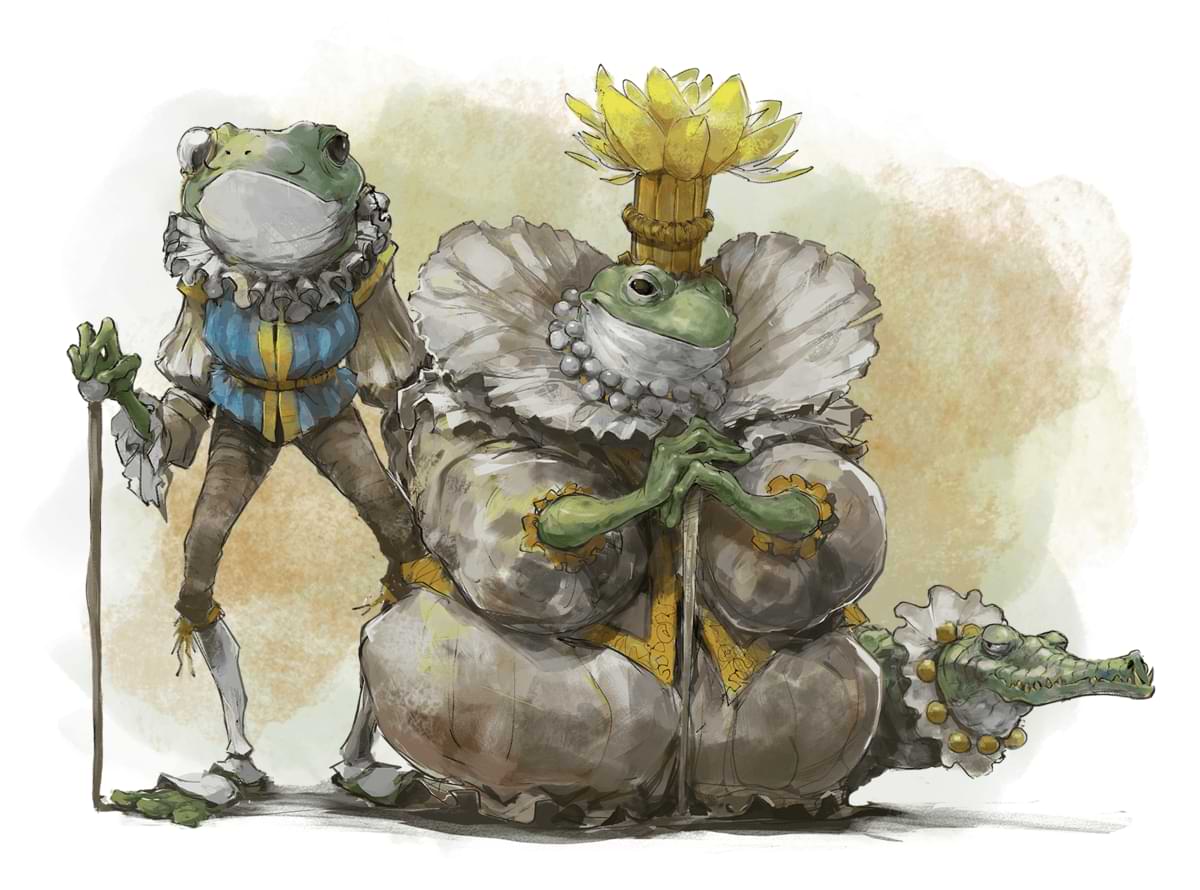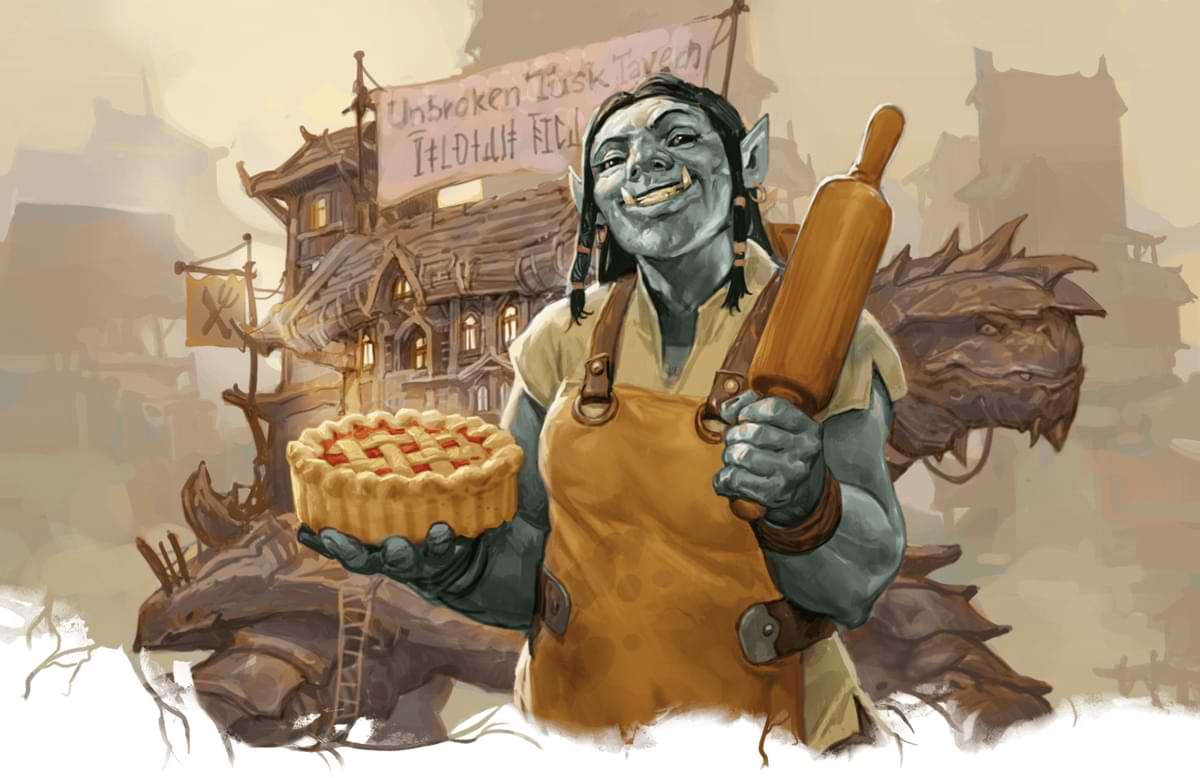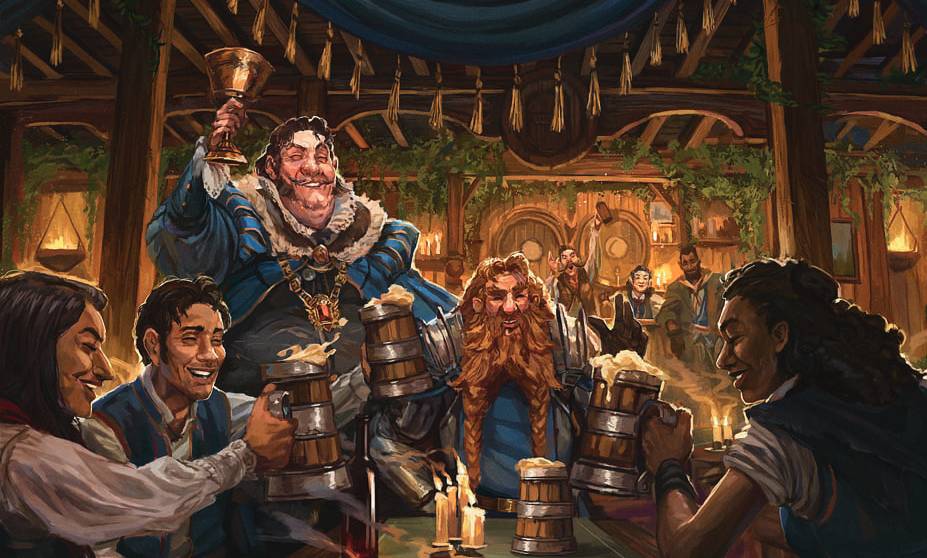Festivals and holiday celebrations on or near the winter solstice have been part of human civilizations for millennia. Many of the traditions of real-world holidays are already a hodgepodge of centuries of cultural minging, which makes them ripe for the picking (and twisting) to pull into a fantasy roleplaying game.
As the winter holidays bring joy and warmth to the real world, we’re here to help you bring “Holiday Special” vibes to your D&D worlds.
- Unwrap the ‘Why’ Behind a Winter Festival
- Using Historical Traditions for Inspiration
- Reindeer Games for Your D&D Party
- Winter Holidays That Already Exist in D&D
- Media Inspiration for Your Holidays
Unwrap the ‘Why’ Behind a Winter Festival
The first step in your journey to building a holiday festival for your table is to determine your motivation for it. This will help you decide how much prep you need to do.
Here are a few different reasons why you might want to do a D&D winter festival:
- In-game calendar: If you’re the type of Dungeon Master that likes to use the game calendar, you’ll likely just come to Midwinter via your in-game time tracking, and having a festival occurring is a good way to mark that.
- Mid-campaign break: Maybe you’ve just come to the end of a major arch and are looking for a brief diversion for your players before you launch the next major plot.
- Family game: Running a D&D game for the family has become a more popular activity for folks home for the holidays. Giving the game a festival vibe might make it easier to entice uninitiated family members to the table.
- Just leaning in: Maybe you and your table feel like doing it because it’s that time of year. The energy is there, so why not own it?
Using Historical Traditions for Inspiration
A great early step in creating holiday traditions for your D&D game setting is to look at traditions in the real world. Seeking out traditions that predate modern festivals can help you find encounters and challenges that fit the moods and flavor of a fantasy world.
Here a few real world historical traditions with examples of how they could inspire a D&D adventure:
Evergreens and Yule Logs
The use of evergreens to decorate homes during the solstice seems to stem back to Roman Saturnalia, and Nordic traditions would have residents seek out large logs that could burn in the hearth for the entirety of the holiday.
Having citizens of a town seeking out the perfect trees and bushes to decorate their homes with, or the perfect log to burn in colder settings, could be an excellent way to start a story. Players could make foraging checks using Wisdom (Survival) to see how well they can find the necessary plants nearby. Plot hooks and complications could come into play if said materials are being poached from a druid enclave or perhaps unsettling a cranky dryad.
Lord of Misrule

This was a popular part of Roman Saturnalia celebrations that was similarly enjoyed in British holiday traditions. A “mock king” role would elevate a servant or slave, or other commoner, to preside over the festival as a temporary ruler. Plot hooks for members of an adventuring party suddenly finding themselves in the position of a Lord of Misrule could be fun.
For DMs wanting to darken their stories, some historians believe the Roman celebrations ended with the sacrifice of this mock king to Saturn. The party might not be keen on going through with that, all things considered, and may need to devise a strategy to escape.
Wassailing
A precursor to modern-day Christmas caroling, wassailing also included the preparation of—wait for it—wassail, a spiced cider drink that would be shared with neighbors. Songs were also sung in exchange for gifts.
To play out the D&D equivalent of this tradition, you could ask the players to make a series of skill checks. These checks could be made as they prepare the wassail and sing, and for social activities as they visit locations around town.
This could be an excellent setup for an investigation plot, too. The adventurers could learn new details about the town or recent events as they visit different locations.
Wild Hunt
Often led by Odin himself, the Wild Hunt is frequently depicted as a time when celestials would tear across the sky causing havoc and destruction, an apt description for the tempestuous winter storm months in northern locales. Some historians believe the earliest Yule celebrations were held due to the belief that the more raucous and joyful a celebration, the more supported or “paved” the pathway across the heavens would be to guide these hunters across while protecting the mortals below.
Unlucky humans who made the mistake of being outside during the nights of the Wild Hunt were believed to be putting themselves at risk of being spotted by this procession and being carried away to a location miles away, if they turned up again at all!
It’s easy to imagine this tradition slotting right into D&D games full of such celestial beings. Could they be a boon to the town? An omen? Have citizens been disappearing, carried off by the Hunt? Is there something impacting the celestials’ skybridge travel that a plucky group of adventurers could help with?
Reindeer Games for Your D&D Party
If you plan to spend a whole session or a significant part of it letting your players mingle at the festival, here are a few games they could encounter and some corresponding skill checks or rolls that would work for them.
Snapdragon or Flapdragon
This was a popular 16th century game involving lighting brandy-soaked raisins on fire and then eating them. No, really. People did this. Other variants included drinking an alcoholic beverage with a lit candle inside the mug to burn you.
The players could make a Constitution saving throw to see how well their characters can manage the burning item. Failed checks could result in a temporary effect such as a -1 penalty to Charisma (Persuasion) checks but a +1 bonus to Charisma (Intimidation) checks to reflect burns.
Ice Kolf
No, that’s not a typo. A predecessor to modern golf, “kolf” in its icy form would be played on frozen surfaces during the winter months and involved knocking a small ball with a club a few yards away to a target.
Players can make the slippery ice DC 10 Dexterity (Athletics) check to see if they can stand on the ice or fall prone, and then make either a Dexterity (Sleight of Hand) or another Dexterity (Athletics) check to see how well they can make the shot.
King of the Bean

Modern versions of this choking hazard game still exist, often referred to as King’s Cake. The game is simple: A single bean or trinket is hidden inside a cake or pastry and everyone eats it, with the person who gets the bean in their portion being crowned king of the feast. This game could play into the Lord of Misrule tradition, or could simply involve a Constitution saving throw to keep from choking on the trinket.
But some versions of the game have the winner supply the cake for the next year. This could be a silly way to seed a plot hook for a future game, considering it’s highly likely that a nomadic pack of adventurers might forget to return with a new cake the next year, earning themselves the ire of a whole town.
Snow Games
Plenty of snow-based games still used in the modern day would lend themselves well to a fun day of D&D-based holiday festivities. Sled racing could require the players to figure out what their characters would make their sleds out of. Their creations could lead to higher or lower DC challenges.
Snowball fights could use the nonlethal improvised weapon and cover rules, and building snow people could require Charisma (Performance) checks for design or Wisdom (Survival) checks for finding the best way to manipulate the snow.
Winter Holidays That Already Exist in D&D

If you are planning on running a winter holiday festival in your game and you’re not using a homebrew setting, here are some holidays that already exist in the D&D multiverse:
Faerun’s Midwinter
These celebrations would probably be most comparable to New Year’s Eve, but the festivals can look very different and go by different names depending on where you are on the continent.
The Sword Coast Adventurer’s Guide, for example, tells us that citizens in colder climates celebrate Deadwinter Day to signify that the harshest time of the year is now halfway over. Meanwhile, the Party at Paliset Hall adventure from Keys from the Golden Vault features a usually sleepy hamlet known as Loch Wynnis that becomes a bustling party locale during the solstice, due to a fey crossing that opens in the lake during this time.
Holidays of Sharn
Eberron has several holidays described in the “Sharn, City of Towers” chapter of Eberron: Rising from the Last War. If you’re looking for something in your Eberron game that feels like a modern celebration of Christmas, however, you might have to homebrew something. It’s good to recall that Eberron is a world still recovering from a devastating war, so a generation creating new and more optimistic traditions would be appropriate for the setting.
Two of Sharn’s holidays do slot in well with some of the other real-world winter holidays discussed above, however. Long Shadows is said to be the night when the Shadow makes nights the longest and most fraught. This leads careful citizens to spend the evenings inside catching up with friends, which calls to mind vibes similar to Deadwinter.
The Hunt, a day in which a wild beast is released into the city to be chased down by willing participants, also could work well for fans of the Wild Hunt mythology who might want to create a mythology that’s more mortal-centric. It’s hard to imagine a day spent in pursuit of a roaming beast wouldn’t lend itself well to celebratory feasts at the end, as well.
Holy Days of Exandria
The Critical Role setting of Exandria has a calendar of holidays, including specific holy days linked to the worship of the Prime Deities. Many of these are described in detail in the Explorer’s Guide to Wildemount, as well as Darrington Press’ Tal’Dorei Campaign Setting: Reborn.
Barren Eve, celebrated in Wildemount, is a more somber holiday on the longest night of winter, one marked by lighting candles to remember those lost in war. A more celebratory holy day, New Dawn, is held in honor of the Changebringer, where feasts are held and hopes for the near year are discussed from dusk till dawn.
Media Inspiration for Your Holidays
If you’re interested in creating a full-on holiday special for your game but aren’t sure how to adapt some of the tropes you know and love into a D&D game, here are a few media examples of ways fantasy and sci-fi worlds have accomplished this.
Fraggle Rock: Jim Hensons’ dancing muppet cousins have had two different specials celebrating the holidays, “The Bells of Fraggle Rock” and “Night of the Lights,” which showcase the different ways Fraggles celebrate similar holiday tropes with fantasy holidays of their own.
Star Wars: The 1978 Star Wars Holiday Special is infamous and famously disowned by George Lucas, but in recent years the Life Day holiday itself has been more embraced. The Star Wars: Life Day Treasury collection of short stories by Cavan Scott and George Mann provide tales of several different winter-style holidays from different cultures around the galaxy.
Discworld: Terry Pratchett’s Hogswatch Night is ostensibly a parody of Christmas, but it works as a fun example of how to take the known trappings of a real holiday and shift them to work in a fantasy setting.
The Guardians of the Galaxy Holiday Special: This special from November 2022 is directly about Christmas, yes, but the opening credits feature a song by a group of aliens played by the Old 97’s which demonstrate a very skewed understanding of what the common modern mythologies of Christmas are. It’s an excellent stepping-off point for how a similar holiday might be perceived in a world free of the trappings and knowledge we normally associate with real festivities.
Rankin/Bass: For decades, Rankin/Bass cranked out animated Christmas specials, many of which will be familiar to audiences, such as Rudolph the Red-Nosed Reindeer or Frosty the Snowman. But much more useful for a Dungeon Master would be projects like The Life and Adventures of Santa Claus, based on L. Frank Baum’s book, which depicts young Santa as a boy named Claus raised by a wood nymph. Or The Year Without a Santa Claus with its Heat Miser and Snow Miser, a pair of ostensibly elementals competing over their role in the holidays. It’s easy to imagine leading an adventuring party across a snowy landscape in a quest similar to the story of a special like this!
And to All a Good Night
Incorporating and adapting familiar holidays into your table can be a great way to create an immersive experience at the table. It allows your players to draw from their own feelings and sense memories and can flip the distractions of the season into enhancements for the story.
Have you had any fun including holidays in your games? Let us know in the comments any fun ways you’ve done so.
Riley Silverman (@rileyjsilverman) is a contributing writer to D&D Beyond, Nerdist, and SYFY Wire. She DMs the Theros-set Dice Ex Machina for the Saving Throw Show, and has been a player on the Wizards of the Coast-sponsored The Broken Pact. Riley also played as Braga in the official tabletop adaptation of the Rat Queens comic for HyperRPG, and currently plays as The Doctor on the Doctor Who RPG podcast The Game of Rassilon. She currently lives in Los Angeles.








-
View User Profile
-
Send Message
Posted Dec 9, 2023First! Lol frog nobility
-
View User Profile
-
Send Message
Posted Dec 9, 2023I was planning on something like this. Also Second
-
View User Profile
-
Send Message
Posted Dec 9, 2023Well said, cheers!
-
View User Profile
-
Send Message
Posted Dec 10, 2023I love the idea of a Miser Brothers adventure - the adventuring party could just be out doing whatever and they get caught in the crossfire between heat miser and snow miser, who could maybe be some higher level elementals, and then the party has to figure out a way to solve the conflict before a local town gets destroyed in the process
-
View User Profile
-
Send Message
Posted Dec 13, 2023I find it odd that you didn't mention Exandria's original winter holiday, the one Matt made for their home game as a holiday session before Critical Role started, Winter's Crest! The holiday and its history is mentioned in Tal'Dorei Reborn, it celebrates the defeat of the ice elemental behemoth Errevon after his attempted takeover of Tal'Dorei. The holiday has bonfires, gift-giving, and best for players, carnivals!
-
View User Profile
-
Send Message
Posted Dec 14, 2023This was fun. However, could there be a follow-up article for people who don't base their fantasy worlds on Northern Europe?
-
View User Profile
-
Send Message
Posted Dec 14, 2023Adventure Hook: The dragon who owns the toy factory just fired a bunch of workers right before the holiday. Can you save the holiday by breaking into the vault and distributing their hoard to the sad workers without getting caught by the evil, greedy, overgrown lizard?
-
View User Profile
-
Send Message
Posted Dec 24, 2023Great idea though why not have a kind of christmas carol version?
-
View User Profile
-
Send Message
Posted Dec 27, 2023How about Jesus Christ?
-
View User Profile
-
Send Message
Posted Jan 5, 2024I like the story
-
View User Profile
-
Send Message
Posted Jan 6, 2024Does anyone have tips for running curse of strahd?
-
View User Profile
-
Send Message
Posted Feb 9, 2025The text says "Dexterity (Athletics)" but when you hover your cursor for the skill description, it says, "Strength (Athletics)".